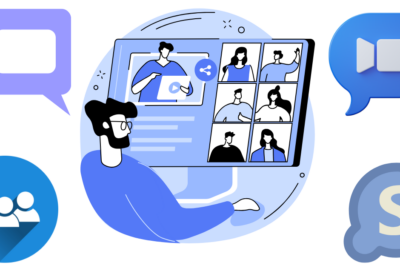Interactive Whiteboard Video Conferencing: Enhancing Communication and Collaboration
Communication has changed in a world where distance disappears and collaboration is global. Interactive whiteboard video conferencing facilitates seamless connections and dynamic cooperation.
Imagine discussing projects with coworkers like you were in the same room, kilometers apart. Imagine teachers captivate students with dynamic lessons from anywhere. Visual engagement, real-time brainstorming, and interactive presentations make virtual meetings come alive.
This blog will discuss its benefits, features, and industry applications. From overcoming remote work gaps to transforming education, this technology is changing communication.
Ready to break barriers and embrace the future? Let’s explore this fantastic journey!
Benefits of Interactive Whiteboard Video Conferencing
Enhanced Visual Communication
Traditional conference calls often need more visual context, leading to misunderstandings. With interactive whiteboard video conferencing, participants can share their screens, draw diagrams, and annotate content in real-time. This visual element enhances communication, making discussions more engaging and understandable.
Real-time Collaboration and Idea Sharing
Interactive whiteboard video conferencing empowers teams to collaborate seamlessly on projects, regardless of their physical locations. Participants can contribute ideas, brainstorm, and work on a shared canvas simultaneously. This real-time collaboration nurtures creativity and accelerates decision-making.
Improved Remote Learning and Training
Education has undergone a digital revolution, and interactive whiteboard video conferencing is pivotal in remote learning. Educators can conduct interactive lessons, share educational resources, and engage students through visual aids. Similarly, businesses can use this technology for employee training, imparting knowledge effectively across the organization.
Interactive Presentations and Brainstorming
Traditional presentations often follow a linear structure, limiting audience engagement. It enables presenters to create dynamic presentations, incorporating multimedia, interactive elements, and live annotations. This fosters active participation and ensures the audience remains captivated.
Key Features of Interactive Whiteboard Video Conferencing
To harness its full potential, it’s crucial to understand its key features:
Digital Whiteboard Functionality
At the heart of this technology lies the digital whiteboard, a virtual canvas where participants can draw, write, and illustrate concepts. This feature mimics the traditional whiteboard experience while allowing for greater flexibility and creativity.
Screen Sharing and Annotation Tools
Sharing screens enables participants to showcase documents, presentations, or applications. Annotation tools enhance collaboration by letting users mark up shared content, making explanations and discussions more precise.
Video and Audio Conferencing Capabilities
High-quality video and audio conferencing are essential for effective communication. Interactive whiteboard video conferencing seamlessly integrates these features, enabling face-to-face conversations and nonverbal cues.
Integration with Other Software and Applications
Many interactive whiteboard video conferencing platforms integrate with popular software and applications to streamline workflows. This integration facilitates document sharing, project management, and seamless tool transitions.
Applications in Business
The business world has embraced it for various purposes:
Virtual Meetings and Client Presentations
Interactive whiteboard video conferencing has transformed the way businesses conduct meetings. Virtual meetings eliminate the need for travel, saving time and resources. Additionally, client presentations become more engaging, allowing for real-time feedback and clarification of concepts.
Collaborative Project Planning and Reviews
Teams scattered across different locations can collaborate on projects efficiently. They can visualize project timelines, allocate tasks, and provide updates through interactive whiteboard sessions. This enhances transparency and accountability within the team.
Training Sessions and Webinars
Training employees or hosting webinars becomes more interactive and engaging. Trainers can illustrate complex concepts, facilitate Q&A sessions, and gauge real-time participant understanding.
Impact on Education
Virtual Classrooms and Remote Learning
Educators can recreate the classroom experience in virtual environments. Students can attend lectures, participate in discussions, and collaborate on group projects, regardless of physical location.
Engaging Students Through Interactive Lessons
Interactive lessons cater to diverse learning styles, keeping students engaged and promoting active learning. Educators can use multimedia elements, conduct quizzes, and encourage group activities to enhance the learning experience.
Global Connectivity for Educational Purposes
Interactive whiteboard video conferencing connects schools and universities with educational institutions worldwide. This cultural exchange broadens students’ horizons, fostering a global perspective from an early age.
Remote Work and Team Collaboration
As remote work gains prominence, interactive whiteboard video conferencing becomes an invaluable tool:
Facilitating Teamwork Among Remote Employees
Collaboration doesn’t have to suffer due to remote work arrangements. Teams can ideate, plan, and execute projects together as they would in a physical office.
Visualizing Ideas and Strategies in Real-time
Whiteboard video conferencing makes it easier to visualize complex ideas. Teams can map out strategies, flowcharts, and diagrams in real time, ensuring everyone is on the same page.
Overcoming Geographical Barriers
Companies with global teams or clients can bridge geographical barriers. This technology promotes effective communication and collaboration regardless of time zones.
Choosing the Right Interactive Whiteboard Video Conferencing Tool
Selecting the right tool is crucial for a seamless experience:
Evaluating Features and Compatibility
Consider the features you need, such as screen sharing, annotation tools, and integrations. Ensure the platform is compatible with your devices and operating systems.
Scalability and Pricing Considerations
If you plan to expand usage across your organization, scalability is vital. Compare pricing plans and choose one that aligns with your budget and growth expectations.
User-Friendliness and Support
The platform should be intuitive and user-friendly, ensuring a smooth learning curve for participants. Additionally, prompt and reliable customer support is essential to address technical issues.
Best Practices for Effective Interactive Whiteboard Video Conferencing
To make the most of interactive whiteboard video conferencing, follow these best practices:
Prepare and Organize Content Beforehand
Plan your content and materials to avoid disruptions during the session. This includes creating slides, documents, and any visuals you intend to share.
Engage Participants Through Interactivity
Encourage participants to engage with the content actively. Pose questions, ask for opinions, and involve them in discussions. This keeps the session dynamic and participatory.
Use Visuals and Multimedia Effectively
Visuals are powerful communication tools. Incorporate images, graphs, and videos to convey complex information concisely. Visual aids enhance understanding and retention.
Challenges and Solutions of Interactive Whiteboard Video Conferencing
Despite its benefits, it also comes with challenges:
Technical Issues and Connectivity Problems
Poor internet connections and technical glitches can disrupt sessions. To mitigate this, test your equipment beforehand and have a backup plan in case of issues.
Managing Participant Engagement
In virtual settings, participant engagement can wane. Combat this by involving participants actively, using interactive activities, and periodically checking for understanding.
Security and Privacy Concerns
Sensitive information may be shared during conferences. Ensure your chosen platform has robust security measures, including encryption and secure access controls.
The Future of Interactive Whiteboard Video Conferencing
The evolution of this technology holds exciting possibilities:
Integration with Virtual Reality and AI
As virtual reality and artificial intelligence advance, they could be integrated into interactive whiteboard video conferencing, enhancing the immersive experience and enabling even more dynamic collaboration.
Evolving Trends in Remote Communication
As remote work and communication become the norm, it will continue to evolve. It will likely incorporate new features and adapt to changing communication needs.
Conclusion
As we end this journey one thing is sure: communication will be interactive, engaging, and limitless. It breaks down barriers, fosters engagement, and streamlines teamwork like never before. The possibilities are endless, from dynamic brainstorming sessions to immersive presentations.
As you begin your next virtual adventure with your digital whiteboard and a universe of possibilities. Explore it and let it change your communication, learning, and creation. Your team’s success is just a click away. Embrace the future of collaboration now!



